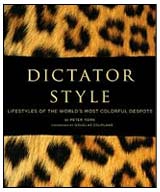Books |
Dictator Style: Lifestyles of the World’s Most Colorful Despots
Peter York
By
Published: Jan 01, 2008
Category:
Art and Photography
Dictator Style: Lifestyles of the World’s Most Colorful Despots
Peter York
At last. A book for that impossible-to-please person. Like…me.
The notorious dictators of the last century killed tens of millions, stole trillions and just generally made everybody within bombing range suffer for whatever it was that set them off in the first place — it’s hard to find the giggles in their lives.
But bless his sick little heart, British journalist and style guru Peter York has trudged into the archives of bad taste and horror and returned with an account that would do Robin Leach proud — a picture-and-text tour of the terrible homes of horrible men.
Once you wrap your head around the concept, it’s a hoot.
“The whole point about being a dictator is that you’re in a class of one,” York writes.
Unlimited power. You and I may dream of it. These jerks had it. And that allowed them “to exercise their fantasies, unrestrained by scale.” Imagine: My game, my rules, no questions.
So if you’re expecting a dictator version of Private Splendor: Great Families at Home, brace yourselves. Dictator style runs to big. To reproductions; they’re shinier, York explains. French, of course. That is, French from the era of gold and glass and marble — French from the era of the great Parisian hotels. And art. If you’re a dictator, there must be art. By which York means: “portraits of you.”
Start way back, with Lenin. He lived like “a left wing intellectual” — he was, in a way — and so his house is kinda nice in its strict simplicity. Later, of course, he moved on to a mausoleum in Red Square.
Stalin was a practical sort. He slept on a divan, but favored large dining rooms. And he had quite the bunker — an emergency cabinet room.
Bertolucci got Mussolini’s taste right in The Conformist: a massive, empty office and a house that was “Roman kitsch”.
Hitler’s Alpine retreat — his only personalized home — featured his watercolors in the guest rooms. In 1938, this house got a lovely write-up in an English decorating magazine; it treated Hitler, writes York, “like an A-list actor with a heavy schedule.”
Nicolae Ceausescu created a People’s Palace that was, in its day, the second largest building in the world. The pictures of weird therapy rooms and equipment are unsettling. But they’re chump change compared with the basement bunkers that represented a third of the palace. Their purpose: store whatever could be sold.
Joseph Mobutu had 11 palaces. (The first alone cost $500 million.) Saddam Hussein had 65, most erected to look like hotels. Except for the art. There’s quite a remarkable painting of a naked blonde in one of his Baghdad joints. Though her breasts are extraordinary, your eye may be drawn instead to the longhaired blond hero who brandishes a sword as he’s embraced by a snake. This is, York enthuses, “art you can imagine in the houses of some of Jerry Springer’s guests.”
It gets dizzying. Manuel Moriega’s Christmas tree. Ferdinand Marcos, embalmed, in a glass coffin. Idi Amin ending up in a Saudi Arabian apartment with shag carpeting and a smoke-glass coffee table.
Curious? Go on. Take a gander. In the Ceausescu palace, feast on the oil painting of his wife — and don’t miss Imelda Marcos as Venus. Want more wretched rooms? Here are Hitler, Stalin and Milosevic.
Flaws? The book’s too thin. Not enough pictures, you’ll say. Don’t blame York. These dictators somehow knew better than to photograph their stolen wealth and let the pictures out.
The text? York is a witty writer, but he does admit that his editor asked him to cut down on his use of “hideous” and “ugly”. No. Sorry. Not possible. “Hideous” and “ugly”, early and often, are what we want.
Just wash your hands after reading.
(Many thanks, W….)
To buy “Dictator Style” from Amazon.com, click here.


